Papillon: features and subtleties of the content
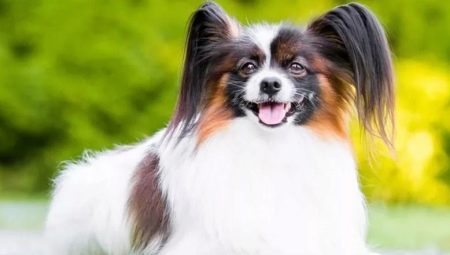
Papillon dogs are incredibly gentle and pretty in appearance. This animal is also called a butterfly because of the interesting shape of the ears, which resemble wings when extended. This feature of this breed is considered the most striking and expressive. Today we will take a closer look at papillon dogs and find out how to properly keep them.
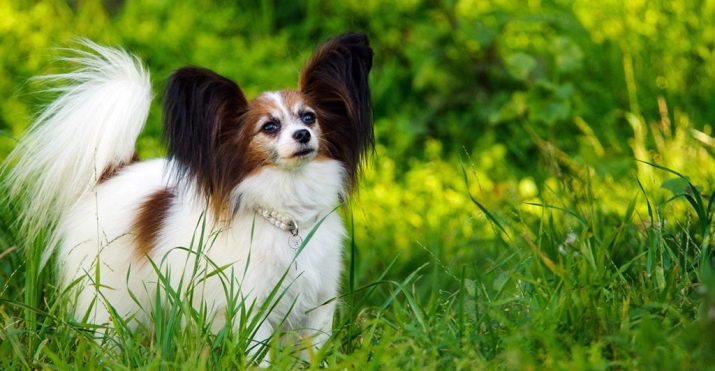
History of origin
The homeland of pets of the Papillon breed is France. In European countries, these animals were known and popular back in the distant XI-XII century. It is believed that the progenitor of the charming papillons is the pygmy spaniel, which was very loved and often bred in Italy and Spain. From the very beginning of the 16th-17th centuries, cute pets of the Papillon breed (otherwise called the Papillon) began to actively gain enviable popularity among members of royal families. Often these dogs were brought up by representatives of the court nobility. Many of the famous artists depicted papillons on their canvases, which once again confirms the fame and relevance of the breed at that time.


King Henry III of France allocated a lot of money from the state treasury for the maintenance of his beloved thoroughbred pet with unusual ears. Queen Marie Antoinette, in turn, considered her portraits incomplete and unfinished until they depicted papillons.
Unfortunately, such a specific attitude on the part of kings and nobles in relation to the Papillons played a cruel joke with the latter. At the end of the French Revolution, dogs of this breed began to be destroyed without a drop of pity and doubt.In this cruel way the end of bourgeois life was celebrated. The papillon population dropped sharply due to such events. Their existence was under great threat. Fortunately, it was possible to save these pets from the complete disappearance of these pets. From the middle of the 19th century, people gradually began to restore this cute breed of four-legged friends again.
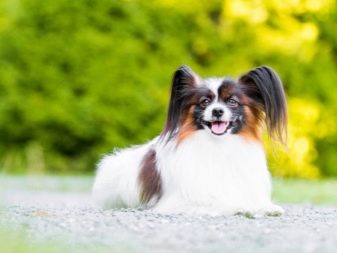

Description
Papillon has another name - the continental toy spaniel. Pets of the described breed are very popular these days. Many people fall in love with them at first sight as they look very friendly and cute. Before you go to the nursery for the acquisition of such a four-legged friend, you should figure out what are the standards of appearance and character traits of papillons.
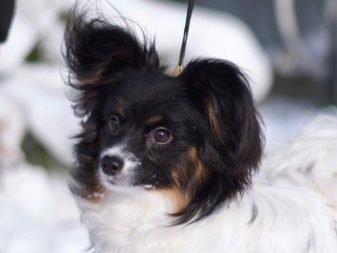
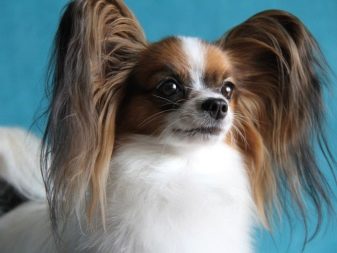
Appearance
The appearance of these pets can be safely called luxurious. Spaniels of this species have a miniature body structure, in which everything is folded harmoniously and proportionally. Papillons are known for their graceful muzzle, small in size and very small in width. The skeleton is strong, but visually it seems fragile and delicate. The papillons move gracefully and beautifully, demonstrating aristocracy and nobility. The body is not very tall, but rather long. A good addition is a solid and soft wool cover.

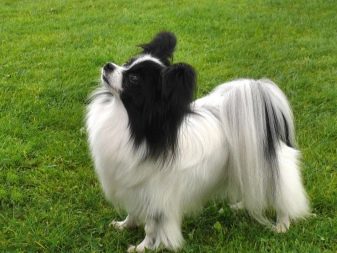
The appearance of the papillons also attracts a lot of attention due to the interesting structure of the ears. In these dogs, they have the original shape of butterflies. The tail of the terriers is pubescent.
The head structure of the continental toy spaniel has significant differences from other varieties of spaniels, being lighter and smaller. Despite the compactness, the head of the papillons corresponds to the structure and size of their body. The skull does not have a perfect and regular round shape. The transition from the forehead to the muzzle is well defined and well defined. The purebred representatives of the French breed should have a small nose. Its shape should be round. The traditional color of the nose is black. If you look from top to bottom, it may seem as if it is slightly flattened, but its back is perfectly straight without irregularities.
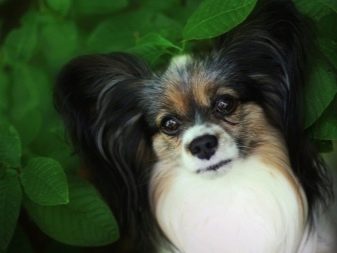

Papillons are characterized by a pointed muzzle. She is a little upturned. The lips of these dogs are distinguished by rich and well-defined pigmentation. They fit as close as possible to the jaws of the animal. They are compressed and have a minimum thickness. Papillon jaws are distinguished by impressive power indicators. Despite their innocent and pretty appearance, these pets are able to demonstrate a very powerful and strong grip, which many simply do not expect from them. By accepted standards, dogs should have a scissor bite.
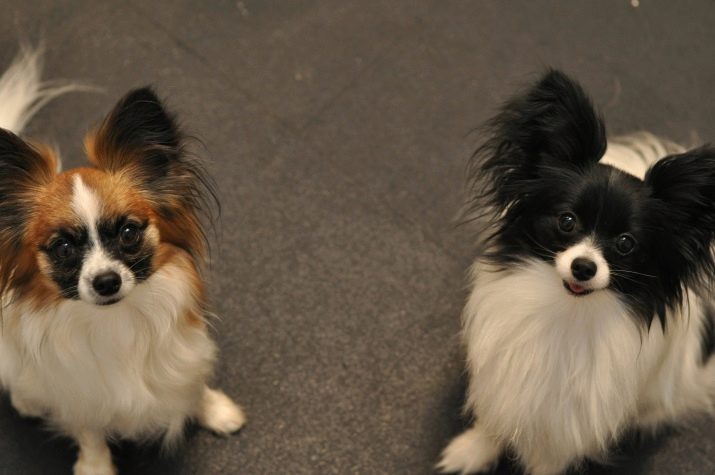
The tongue of purebred individuals that meet all the requirements of the standard must be reliably hidden behind the teeth. If it protrudes beyond their limits and never "hides" in the inner part of the oral cavity, then this will be a serious defect in importance. Such a pet is unlikely to be admitted to exhibitions or various competitions. Papillon's eyes are always wide open. They are distinguished by their large size and almond-shaped structure. From the side it seems that the eyes of these pets are set too close to each other, but the most important thing is that they are not convex. The papillon butterfly's gaze is expressive and bright. The color of the eyes according to the standard should be dark. In such animals, there is a pigmented eyelid.
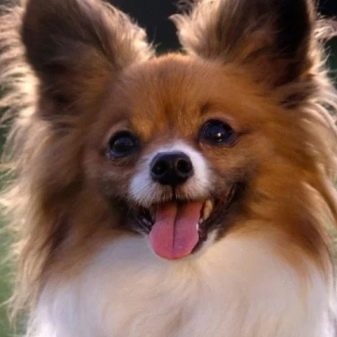
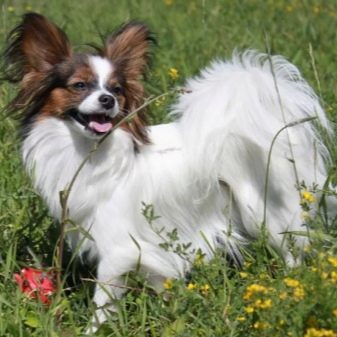
One of the most unusual details of the breed is its amusing ears. They are large in size but supplied with good strength. Hanging ears and erect ears are both subject to the same accepted standards. So, the tip of the auricle should end with cartilage of great rigidity. The ears should be pushed back slightly on the dog's head.The distance between them should be such that it was possible to calmly and clearly see the neat round shape of the dog's skull.

There are two main varieties of these modest spaniels - papillons and phalens. Their main difference from each other lies in the fact that in the first individuals the ears have a standing structure, while in the second they are hanging. If we are talking about a papillon, then his ears should be set high by international standards. The auricles will always be wide open and turned to the sides. The outer wall of the ear in pedigree individuals is solidly covered with wool. The closer to the edge of the ear, the longer the hair will be.

The neck of purebred miniature French spaniels is not very long. In the occipital region, it has a characteristic slightly curved structure. The tail of the papillons is distinguished by good pubescence and is located high on the dorsal line. From the side, the tail of these dogs strongly resembles a small fountain with water jets gushing from it. In moments of excitement, this part is usually thrown on the back of the animal or on the thigh.
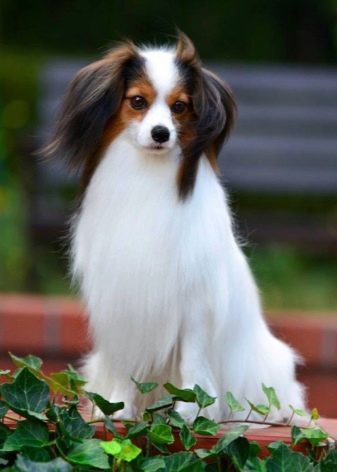

When the tail of a butterfly pet turns into a ring or a half-ring, this will indicate that the animal in its external characteristics seriously deviates from all recognized standards. The same applies to those cases when the papillon's tail simply lies on its back. It shouldn't be like that.
The paws of the French handsome man are long in relation to their body. A comparison is often made here with hare feet. The claws of purebred individuals grow dense and powerful. They usually have a characteristic dark color. If the coat is distinguished by light tones, then in this case, snow-white claws are permissible. On all paws, the fingers of these dogs are highly mobile. Thick wool grows between them.

Character
You should not rely only on the external characteristics of French spaniels in the desire to acquire such a thoroughbred puppy. It is important to pay due attention to the character traits of this famous breed. Only knowing the characteristic behavior and habits of papillons, you can make an informed decision about their acquisition. For many years, representatives of this famous French breed have not left the ratings of the "smartest dogs on the planet." The intelligence level of the Papillons is really quite high. For this reason, one should not treat these pets with disdain, naively believing that they can be easily deceived or outwitted, and they will not understand anything. If you are looking for a cute fluffy "toy", then the Papillon is not your option.

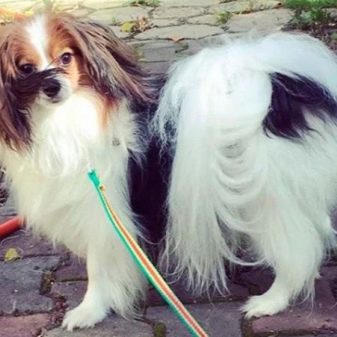
Natives of the French breed are insanely loyal to their owners. They are loyal and benevolent. Since "butterflies" are characterized by modest miniature dimensions, they are considered to be "eternal children". However, papillons will not constantly sit in one place and indifferently look at what is happening around. Such behavior is not in the nature of these animals. Pedigree pets are great lovers of play and frolic. They are curious and interested in everything that happens around them, constantly discovering something new for themselves.


The papillon can hunt its chosen prey with great interest. The latter can be small objects - mice or flying insects.
Despite the playfulness and funny behavior, papillons require competent and timely socialization... If you neglect these stages of raising a dog, then in the end there will be no trace of the friendliness and benevolence of these animals. Pets will quickly cross the fine line between play and aggressive behavior, they can even bite painfully. Such behavioral features of the dog will soon become a habit.
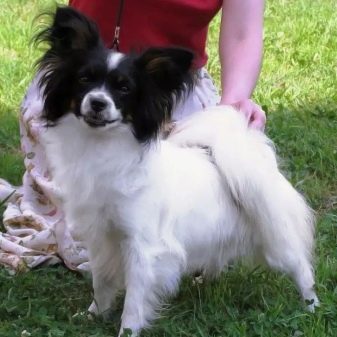

The socialization and education of the papillon must be dealt with from puppyhood. If you do everything correctly and consistently, then in the end you can get a real loyal friend who will not disappoint you with his behavior and actions. Papillons are optimistic dogs. They are distinguished by a cheerful and positive disposition. Such a pet can easily cheer up its owner even on the "grayest" day. Another distinctive feature of the animals of the described breed lies in the fact that they accurately feel the mood of the owners and their feelings at a certain moment. For example, if a person wants to be in a calm atmosphere and is not ready to play with an animal, then the papillon will easily tune in to a similar wave. Such a pet can become a good participant in games with children.
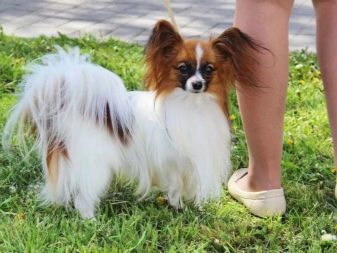

Papillons are very strongly attached to their dear owners. In a way, this attachment should be called "sick." This feature of this breed forces the owners to spend a lot of time with their pets. Leaving the papillon alone is not recommended, especially when it comes to a long time. Loneliness is not good for French dogs. If the papillon is left alone for a long time, he will become seriously yearning and sad. Such sensations will lead to emotional discomfort in the four-legged. In certain cases, these pets may even start to get sick, being left without an owner. Because of this, the papillon is recognized as an animal that cannot bear cruel and rude treatment. Too harsh intonation or physical punishment can cause a pet a lot of pain and resentment. French spaniels are so sensitive and vulnerable that they can harbor resentment, even if you shout at them a little or express something in a rude manner.

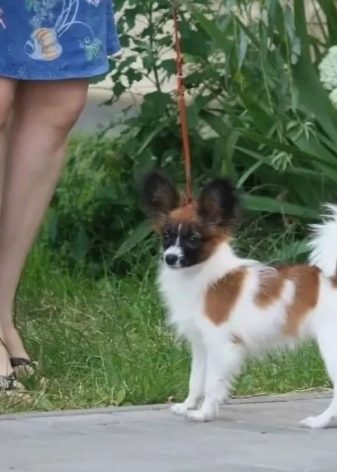
The nature of the papillons can be safely called human. These pets have not only a sharp mind and quick wit, but also a wonderful memory. Purebred Papillon is touchy and open, curious and playful. These pets often show a jealous attitude. Usually papillons are jealous of their owners for other pets, but there are cases when such dogs feel jealous if their owner communicates with other people, even if they are close ones.
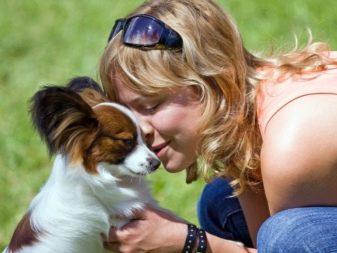

Behavior, which is absolutely not typical for papillons, is unreasonable barking and howling. If this pet decided to bark at someone, then there will be very serious reasons for this.
Colors
Traditionally, the coat of papillons has a characteristic white color with spots of different colors. The latter can be dark, red, pale yellow or chestnut. Mottling is allowed, but it does not always have a positive effect on the appearance of the pet. The most popular and widespread colors of this breed are:
- white-sable - with this hair color it is distinguished by a red and black tint, usually "sable" is visible on the ears;
- tricolor (or tricolor) - this color is recognized as the most unusual;
- bicolor - black and white or red and white colors;
- hound-tricolor - in this case, there is “sableness” on the head of the animal, and one or more dark spots are present on the body.
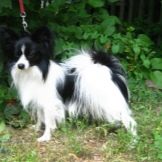



Advantages and disadvantages
Papillons, like representatives of any other known breeds, have both pros and cons. The advantages of individuals of the described breed include the following points.
- Intelligence level. The mental abilities of these pets are incredibly high. This makes them stand out from the large list of decorative species.
- Curiosity, interest in everything new. These qualities make the process of education and socialization of the papillon easier and faster. Learning such a dog is interesting and simple. The papillon commands are mastered in the shortest possible time. By doing everything right, pets do not require praise or treats for their actions. The biggest reward for the "butterfly" is the joyful emotions of the owners.
- Devotion. The papillons are characterized by special devotion.For them, it is paramount that loved ones are always with them and do not leave them alone. Such features determine the possessive nature of the French breed. If the dog is in the company with the owner, it can easily adapt to any circumstances. Therefore, you can safely take papillons with you on trips and travels.
- Friendly and tolerant attitude towards younger family members. If a child wants to play and have fun with the papillon, he will never leave him unattended. Joint games with children for these pets is a great joy and pleasure.
- The presence of other animals in the house does not create problems. Papillon can live in the same territory with other pets. Animals of this breed can establish good contact with both cats and dogs. If the owner works a lot and his schedule is irregular, then it is even recommended to have another pet so that the thoroughbred Frenchman is not sad. You should not start rodents - the papillon perceives them as prey.
- Nice appearance. A charming and captivating appearance is one of the greatest positive qualities of a papillon.
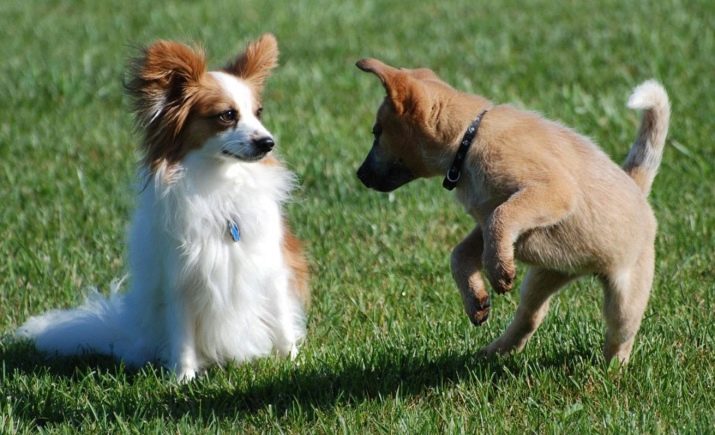
Consider the disadvantages of dogs of the described breed.
- Active weight gain. It is very important to consider that purebred papillons are prone to incredibly rapid weight gain, which as a result results in pet obesity. The diet for such an animal must be selected with the utmost care. An exceptionally healthy and balanced diet of the highest quality should be preferred. Regular physical activity is also important for these dogs.
- Poor attitude towards noise and crowds. Papillons are not very fond of being in a noisy environment where many people are present. If the house is often visited by guests, then it is advisable to close the pet in a separate room when they come. If you do not follow this recommendation, the animal may become too aggressive and vicious.
- The need for careful care. Papillons belong to the category of indoor decorative pets, so they need scrupulous and constant care. All the required activities and cosmetics for such dogs can cost the owners a tidy sum. This is one of the main reasons why people refuse to buy these purebred animals.
- Health problems. Purebred papillons are susceptible to all sorts of diseases. Many individuals suffer from dental ailments. Dislocation of the patella is common. Such problems concern most of the breed. This is usually due to the dishonest attitude towards them on the part of the breeders. Having such an animal in the house, you will have to regularly visit the veterinarian and resort to preventive measures. Otherwise, the pet will get sick.
- The weak point is the woolen cover. The coat of French toy spaniels will have to devote a lot of free time. This is especially true when you have just returned from a walk with your dog. The animal must be bathed and combed on time. If you dismiss the bath procedures, then soon a thoroughbred dog will look like an ordinary unkempt mongrel.

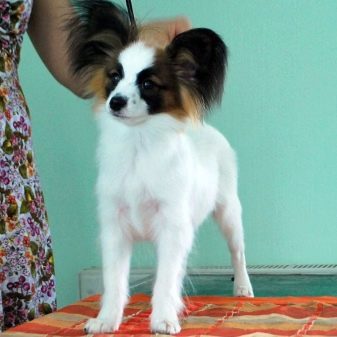
If you decide to have such a pet, you need to consider not only its positive, but also its negative qualities. If you agree to put up with all the difficulties that may affect you and your four-legged friend, then you can think about meeting with the breeder.
Selection recommendations
If you have weighed all the pros and cons and decided to have a papillon puppy, then you should heed some guidelines for choosing a healthy four-legged friend.
- It is recommended to buy puppies of this breed only in well-known kennels with a brilliant reputation. It is also permissible to contact professional papillon breeders.
- If you are choosing a kitten not to participate in exhibitions and competitions, then you should pay attention only to the appearance and behavior of the pet. Puppies should not be too lethargic or painful, eyes and ears should be clean.

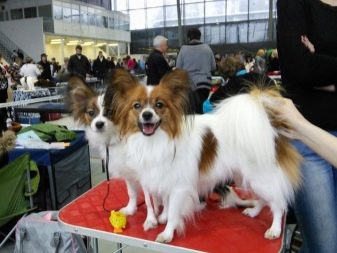
If you want to purchase such an animal for professional maintenance and attend various exhibitions with it, then you should pay due attention to a number of important criteria.
- Take an interest in the pedigree of the producers. The parents of your chosen pet must participate in exhibitions and take prizes if you want to acquire a future winner. It is advisable to familiarize yourself with the awards and certificates of the father and mother of the little papillon.
- The appearance of the puppy must meet all international breed standards. If there are even small and almost imperceptible defects, then the pet will not be allowed to the exhibitions.
- The physical development, weight and height of the baby must correspond to his age and established standards.
- All parts of the body and the head of the little papillon should be in proportion.
- The tail and other limbs must be positioned correctly as required by the standards.
- The puppy's behavior also needs attention. A young papillon should not show excessive aggression and anger. He shouldn't be too shy either.
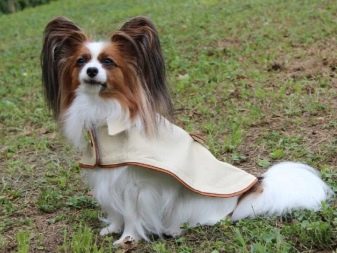
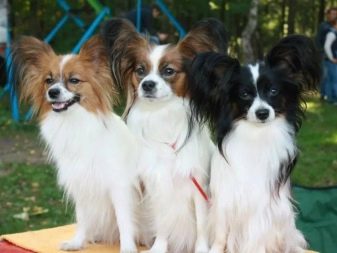
If you are looking for a guard for an apartment, then you need to pay attention to the temperament of the chosen puppy. He must respond to all your provocations, be restrained and even a little cold. From such a baby, a brave dog will subsequently grow, which can become a good defender. Please contact only trusted breeders. The nursery you are going to go to must be famous. His reputation must be perfect. The breeder must provide you with all the necessary documentation and certificates for the pet.
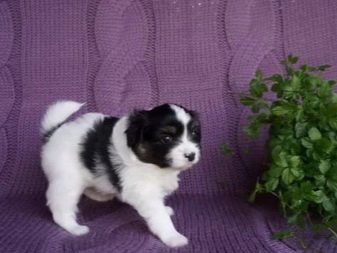

Never be in a hurry when choosing a purebred puppy for yourself. Spend a lot of time on the selection of "your" pet. Take a closer look at the puppy. Pay attention to his behavior and habits. The baby's appetite should be healthy. Only after evaluating all the qualities of the papillon, you can make the right choice, which will not disappoint the owner in the future.
What to feed?
This famous French breed is required to be fed only high quality food. The pet's menu must be composed correctly so that it receives all the necessary vitamins, minerals and trace elements. Papillons are not very demanding when it comes to feeding. They can be fed ready-made dry food or organic foods. If you want to feed your pet with industrial food, then you should choose only expensive premium and super-premium products from well-known brands. You cannot raise such dogs on cheap economy-class food - they can cause irreparable harm to the health of animals.


The finished food should be ideal for the Papillon breed. Sometimes these dogs have problems after consuming dry food - toothache, allergic reactions. It is recommended to select such food according to the recommendations of a veterinarian, so as not to harm the dog.
Many owners prefer to feed their thoroughbred companions with natural products. It is forbidden to give pets such food:
- pork or lamb;
- milk (both raw and boiled);
- bones;
- any products not of the first freshness;
- salty and food with spices / seasonings / onions / garlic;
- any sweets, especially chocolate and pastries;
- smoked, spicy and pickled foods.


The diet of these pets should be based on the following natural products:
- eggs;
- lean meat products;
- cooked offal (it is allowed to give boiled liver, kidneys, heart, spleen);
- dairy products such as cottage cheese, yogurt or low-fat kefir (dairy products should not contain sugar and flavorings);
- raw and stewed vegetables;
- fresh fruits and berries (it is better not to give exotic tropical fruits);
- rice, buckwheat, millet.


Small puppies need to be fed 4-5 times a day. The portions should be small. It is advisable to give babies fresh low-fat kefir, cottage cheese, oatmeal or rice. If you want to give meat, it should be boiled chicken breast or lean veal. Fish can only be seafood. It is recommended to boil it for 5-7 minutes.
It is important to take care of the full and healthy nutrition of the papillon. They should be fed by the hour. Adults should be given food twice a day. This breed has a great appetite. Dogs are prone to overeating. Do not feed your miniature pedigree pet, otherwise he will face serious problems associated with the gastrointestinal tract. Diseases of other internal organs, obesity are possible. With such ailments, pets do not live as long as they could.

How to take care of it properly?
Papillon needs competent and regular care. If you neglect this requirement, the pet will quickly lose its visual appeal and look unkempt. In some cases, the health of a purebred dog may also suffer. The pride of the papillon is his luxurious wool. It is required to take care of her daily. It is allowed to comb out the woolen cut with a special brush or a mitten with teeth. For hygienic purposes, it is recommended to periodically trim the pet's fur on the belly and in the paws. A haircut can be done at home, or you can contact a specialist who can professionally groom a miniature dog.
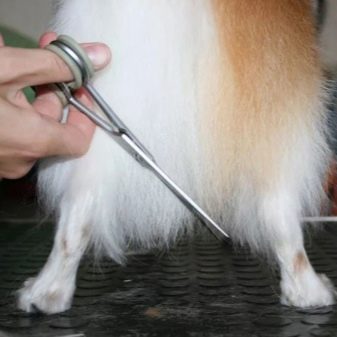
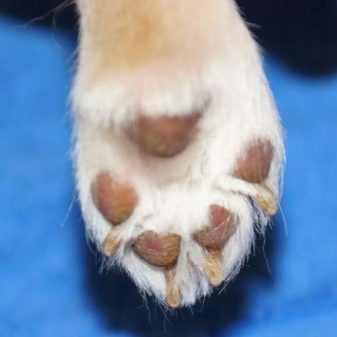
Bathing the papillon should be carried out as needed. When the dog becomes dirty, then it is worth resorting to bath procedures. For washing, you should only use a special shampoo for dogs. These things are sold in many pet stores. Shampoos used by a person are rarely suitable for such procedures. Some breeders use human formulations for platinum blondes to maintain the light color of the animal.
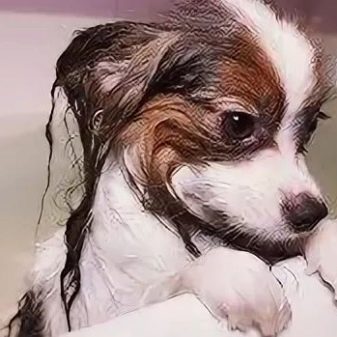

The condition of the papillon's coat is an indication of the state of the dog's health as a whole. The coat should be thick, clean and shiny. If the shade of the fur coat has faded, a profuse molt has begun, then this may indicate bad changes in the body of a four-legged friend. In such a situation, it is important not to waste time and contact your veterinarian as soon as possible.


Take care of the papillon's claws. Check them regularly. Trim as needed and do it as gently as possible so as not to harm the dog. Keep your pet's eyes and ears clean. Remove all secretions in these areas using cotton pads and special fluids available from veterinary pharmacies. If you notice suppuration or inflammation in the ears or eyes, then you should immediately go to the veterinarian.
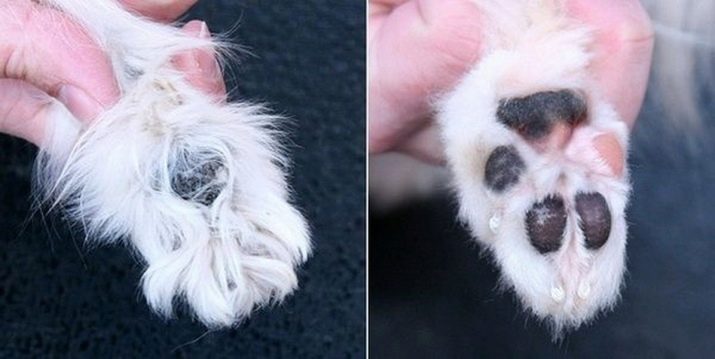
The content of the papillon is not complete without a walk. These pets are ideal both for keeping in a country house and within the walls of a city apartment. Papillons love to run, frolic and play, but they also feel comfortable in an enclosed space. Walk with this French breed every day. It is advisable to get out a couple of times a day. Use a dog harness. Walk your dog for at least 20-30 minutes.


Take care of the upbringing and socialization of your pet in time. Lost time cannot be returned. It will be impossible to fight with an ill-bred dog. The behavior and character of such a pet is unlikely to please the owners.
How to educate and train?
Papillon will demonstrate his best qualities if he is properly educated and responsibly approached to his training. These processes should bring only pleasure to both the owner and the pet. Please be patient before training your dog. Training can be done at home or outdoors.The first thing to teach a puppy is to understand where his place is in the house. "Butterflies" are incredibly sensitive and easily offended, so you shouldn't cry out for them. Pronounce all commands clearly and clearly, but do not shout. Once the puppy knows where it belongs, it will need to be toilet trained. At home, a dog should relieve itself only in a designated place.
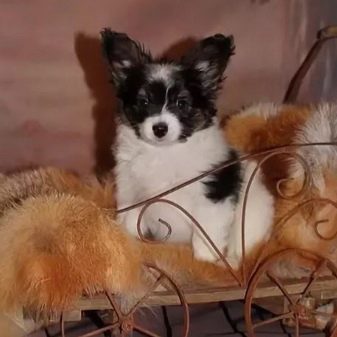
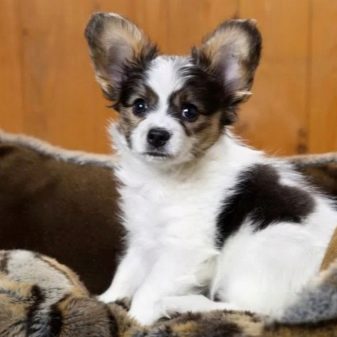
Train your baby to leash and collar in time. Don't be too intrusive. Don't force your dog to do what you want to do. Act as gently as possible so as not to harm the mental state of the pet. If during a walk you notice that the dog is too scared or trembling, then you should carefully pick it up and find a place where there will be no unnecessary noise and a large crowd of strangers. In such conditions, the little papillon will relax and quickly adapt to the environment.


Being engaged in training the papillon, you need to correctly show him that you are the "leader", leader and head of the house. Become a real authority for the dog, who will explain everything to her and show him how to behave correctly. The main thing that a young dog must master and understand is his nickname and basic commands ("lie down!", "Sit!"). After that, you can move on and teach your pet the commands "Voice!", "Near!", "Wait!" Don't be discouraged if it doesn't work the first time. Papillon is a living being, not a robot. He needs some time to understand what the owner wants from him.


If you are tolerant of raising a pet and do not give up after the first setbacks, then you will be able to raise a true faithful friend who will love you more than anyone else in the world.
Reviews
Nowadays, papillons are widespread. Many people give preference to representatives of this breed, wanting to get a good-natured and intelligent friend who can feel comfortable in a city apartment. Different people leave different reviews about these pets. Owners of papillons notice such positive qualities in them:
- excellent mental abilities;
- affectionate behavior;
- friendly and non-conflicting disposition;
- sociability and curiosity;
- cleanliness;
- not selfish character;
- unobtrusive behavior;
- miniature sizes;
- convenient to take with you on trips and travels (many owners go on vacation with these adorable pets);
- lack of unpleasant "dog" odors;
- easy learning.


Mostly the reviews about this breed are positive. The owners of such dogs are delighted with their behavior and level of intelligence. As for the negative aspects of the papillons, here people noticed the following:
- in some owners, dogs begin to bark even at small rustles;
- the need for regular and thorough care (not all owners notice this minus);
- puppy pranks leading to bitten shoes and furniture;
- they do not tolerate loneliness, so they cannot be left alone for a long time.

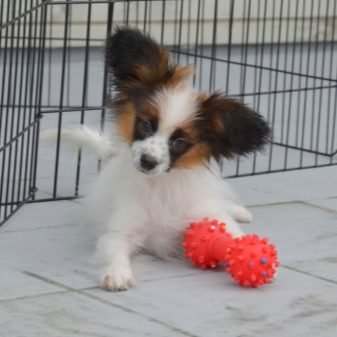
Many owners do not see a single minus in their pets. Most of these problems can arise due to the fault of the owners, who missed something in the upbringing of papillons.
Helpful hints and tips
Do not be alarmed if you notice that the pet's color has changed. The coat color of the papillons changes as they grow. The real color is fixed by 6 months, but during life it can change. Only clean and slightly moistened wool is allowed to comb. If you do this without first wetting, it can lead to brittle hair of the animal. When choosing a puppy, a test for congenital deafness should be done. To do this, clap your hands loudly over the head of the animal. If the pet is healthy, it will definitely react to sudden and unexpected noise.
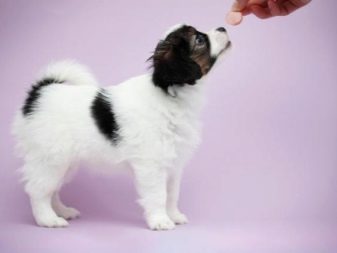
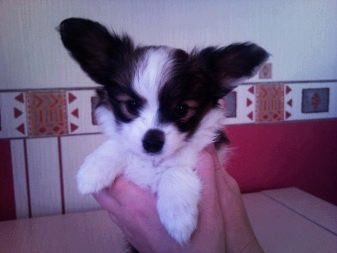
It is better to limit such a pet in excessive activity, because it can lead to injuries to the limbs during unrestrained jumps. The food bowl should be placed on a hill so that the dog does not bend, which can lead to deterioration of its posture. Never overfeed a papillon. The risk of obesity in these dogs is very high. If you notice a deterioration in the health of a dog of this breed, then you should not waste time in vain. Don't diagnose yourself. Go to the veterinary clinic as soon as possible.
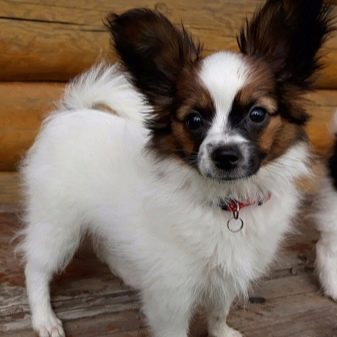

If you have never dealt with such a breed, then it is better to first consult with specialists to find out how to care for and communicate with these pets. Check with the breeder from whom you are buying your puppy on how to properly care for it. It is advisable to draw up a complete diet with a veterinarian. Do not have such a pet if you are not sure that you can raise it correctly and become a true friend for it. Papillons are madly attached to their owners and may not survive betrayal. That is why you need to think a hundred times whether such a dog is right for you, so that you do not subsequently inflict serious psychological trauma on it.
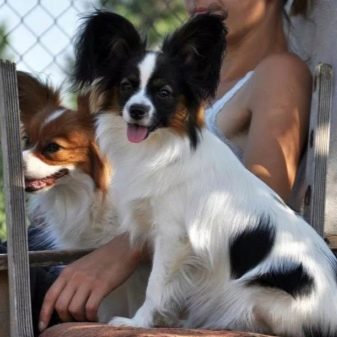

For information on how to properly train the papillon, see the next video.







































Caring for the coat is not difficult at all, because there is no undercoat, it is enough to comb and sometimes wash with shampoo. The Papillon is a very healthy breed compared to many others.